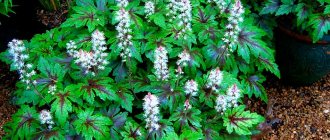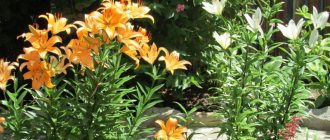Features of growing daylilies and caring for them
Daylily belongs to the genus Hemerocallis. In the wild, it can be found in the south of the Far East in China and Eastern Siberia. There are more than 700 varieties and hybrids of daylilies in cultivation with flowers of any color, except pure black and completely white.
According to the method of vegetation, daylily flowers, planting and caring for which are simple, are divided into deciduous and evergreen. The former are characterized by loss of foliage in autumn and a state of deep dormancy in winter. There are usually no problems with the safety of daylilies with proper care. Evergreen species of daylilies do not lose their foliage; in tropical conditions they continue to grow all year round and bloom regularly three times during this time. But in the middle zone they will not be able to survive the winter without thorough shelter and proper care.
There is an intermediate type - semi-evergreen daylilies. They are not as sensitive to low temperatures as to their sharp fluctuations during the winter.
Advice! Such daylily hybrids will also have to be covered, regardless of the time of planting.
In general, this culture is quite flexible and, with proper care, can be very decorative: the best daylily hybrids can have up to 50 flowers on one peduncle, which bloom gradually. Growing daylilies in open ground begins with planting them. You can simply divide an existing flower, providing it with proper care in the future.
Types and varieties of daylily
Natural views
In nature, daylilies grow along the edges of forests, in partial shade. They are immune to diseases caused by fungi, resistant to attacks by pests, and can easily tolerate dry summers, as well as excess moisture. They live long. They are easy to care for. The most widespread species are red daylily Du Maurier daylily, lemon yellow daylily daylily .
daylilies are eaten using flowers and buds, and salads are made from young leaves. The leaves are used for liver diseases and as a mild sleeping pill.
Daylily hybrid or garden
This is the collective name for hybrids, there are more than 60,000 of them:
Daylilies of the Double group:
- Double Dream with apricot-colored flowers;
- Double Cutie with greenish-yellow flowers;
- Double Classic;
- Double Red Royal with scarlet flowers.
These are double flowers that have additional perianth petals.
daylilies :
- Helix with bright yellow flowers, which have a crimson tint at the edges;
- Grape Witch with many lilac-scarlet flowers;
- Arms to Haven;
- Starp Twister;
- Free Healing with cream buds.
These are varieties with flowers that look like arachnids.
daylilies (Apple Spring, Oda to Fach, Pandora Box) - have a strong smell.
daylilies (Apple Blossom White, Ruffled Parchment, Granny Smith). It should be noted that there are no pure white flowers in nature. Because of this, breeders call these varieties “near white,” which means “almost white” in English.
Watch the video! Daylilies
When to replant daylilies: in spring or autumn
Daylily is one of those few flowers for which a properly transplanted plant is not too traumatic. Therefore, to the question of when to replant daylilies, the answer can be that replanting can be done throughout the entire growing season, as long as there is enough time for rooting. Proper aftercare is also important. Planting can be done in the spring, when the daylily leaves grow to a height of 10 cm, and even in the summer, if necessary.
Advice! When planting daylilies in summer, it is better to do this on a cloudy, cool day or in the evening, shading the plant from the sun at first.
Care during this time should be thorough.
When planting daylilies in the fall, the timing depends on the weather. It will take 1 to 1.5 months without frost for the daylily to take root. Experienced flower growers recommend planting at the end of August, when they have finished blooming. But the best results are obtained when planting daylilies in the spring - the plants will have a whole growing season to take root and get stronger.
How to plant daylilies
It has long been known that daylilies are able to grow in any conditions and, by paying a little more attention to them, the flowering results will be much better. This type of flower loves sunny areas or partial shade, is not afraid of gusty winds and prefers to have a lot of free space around it.
Daylilies are not too fond of being next to shrubs and trees, which become a kind of competitors for a place in the sun. Perennial varieties with light flowers are usually planted in more sunny places, and for red and purple species that cannot stand the scorching midday rays of the sun, slightly shaded places are looked for.
If you choose the right area where to plant and grow daylilies, then these flowers will grow, bloom and form into wide, lush shrubs for many years without making any special demands. To simplify caring for plants, during planting they look for places that do not flood in the spring. The powerful root system of the crop should not experience discomfort from the close occurrence of groundwater.
Planting daylilies
How to plant daylily
Although daylily is a long-liver and can grow in one place for up to 15 years, you should not wait that long to transplant. The plant tends to grow, flowering declines, and the flowers themselves become smaller. In practice, transplantation of daylilies, combined with division and subsequent proper care, is carried out once every 5 years.
Preparing the landing site
If species yellow and red daylilies will grow in almost any conditions - it’s not for nothing that they are called flowers for lazy people, then for exquisite hybrids you will need to create all the conditions for care in order to admire their luxurious flowering. And the first rule of caring for daylilies is soil preparation. There are many requirements for it:
- high fertility - there should be a lot of humus in the soil;
- loose structure;
- moisture and breathability;
- neutral or slightly acidic reaction - pH ranging from 6 to 6, 7, acceptable from 5 to 7;
- The depth of the fertile soil layer should be large - up to 50 cm.
Important! Hybrid daylilies grow best on fertile, loose loam.
All other types of soil will have to be improved:
- sandy soil requires the addition of clay and a large amount of rotted organic matter;
- Coarse sand, peat, compost are added to clay soil and drainage is required.
There should be no weeds in a flower bed with daylilies - this is one of the basic rules of care. If it is planted on virgin soil, all the roots of weeds must be removed in the fall, and the planting of daylilies should be carried out the following spring. In autumn, lime the soil if the acidity is too high.
Under digging for 1 sq. m add 10 kg of humus. 10 kg of chernozem is added to sandy soil, and the same amount of sand to clay soil.
It is also important to choose the right site for planting daylilies: natural species will do well in partial shade, but hybrids need full sunlight. Only dark-colored daylilies require partial shade during the day to prevent the flowers from fading.
Attention! Even on the south side of bushes or trees they should not be planted close: competition for food and moisture will be inevitable.
When choosing a site, you need to pay attention so that water does not accumulate on it during rains in summer and after snow melts in winter, otherwise caring for the plant will not be beneficial. If there is no such area, but you want to plant daylilies, you will have to do drainage and arrange high ridges.
Preparation of seedlings
With proper care, daylilies can be stored for almost a month before planting. You just need to wrap the roots in a damp rag or sprinkle them with a damp sand-peat mixture. Leaf blades should be cut by a third - this will reduce moisture loss.
If the daylily roots are still dry, they are soaked in water for 3-4 hours. Then all non-living ones are removed, and healthy ones are trimmed, leaving a length of 25 cm.
Advice! During care, cut areas should be sprinkled with a fungicide so that they do not become a gateway to infection.
Before planting daylilies, leaf blades, if this has not been done before, are cut by a third to balance the above-ground and underground parts of the plants. This will make maintenance much easier in the future.
Planting daylilies in open ground in spring
As with any time of planting, it should begin in the spring by preparing the planting hole. The distance between neighboring daylily bushes is chosen to be 60-70 cm, taking into account that the plants grow quickly. Only for low-growing border varieties this distance should be reduced to 40 cm.
Planting daylilies in the ground in spring consists of several stages:
- The hole should be 30-40 cm deep and 30-40 cm in diameter - approximately 1.5 times the volume of the root system.
- The planting mixture is prepared from excavated soil mixed with leaf humus and aged non-acidic peat.
For each bucket of such soil add 30 g of potassium salt and superphosphate, a handful of ash. Attention! Excess nitrogen is harmful to daylilies - it stimulates the growth of leaves to the detriment of flowering. This is important to consider when leaving. - At the bottom of the hole, a planting mixture is placed in the form of a mound, on which the daylily roots are spread.
- Cover the plants with the remaining mixture in several stages with intermediate watering so that the soil adheres better to the roots.
- It is very important to correctly position the root collar of the daylily. She needs a depth of 2 cm on heavy soils and 3 cm on light soils. Planting too deep weakens the plants, and if planted too shallow, the roots may end up on the surface after winter.
In conclusion, the daylily plantings should be well watered and the soil underneath should be mulched with chopped tree bark or straw. This will make further care much easier.
Landing
This procedure begins with the planting bulbs being soaked in water or liquid mineral fertilizer (very weak concentration) in advance of planting. The roots should swell and come to life so that you can see which roots should not be left. The remaining strong roots need to be shortened to 25 cm. Now you need to dig a hole about 30 cm deep for each bush or division in the open ground.
Remember that the daylily settles here for a long time, so when the bush grows and increases in diameter to 60 cm, it should feel free.
In each hole we place mixed humus, sand and peat, add to them ash mixed with superphosphate or potassium-phosphorus fertilizer. All this should have the shape of a mound. We place the roots in the hole and distribute them over the mound. There should be no void under the roots. We fill the hole with earth, but not completely.
Next, you need to thoroughly compact the soil around the plant and water it generously. The hole should be completely filled with water. Water should not be absorbed quickly. Then the hole is filled completely. You need to make sure that the root collar is not deeper than 3 cm in the ground. Because of this, the plant will lag in growth and may even rot.
If everything is done correctly, the plant will take root well.
How to care for daylilies
These are not very demanding flowers to care for, but properly carried out agrotechnical measures will help to grow them healthy, which is the key to decorativeness. Caring for daylilies varies depending on the season. It also depends on the type of soil in the flower garden: sandy and sandy loam soils suffer from drying out in the heat, nutrients are washed out of them more quickly, which means that daylilies will have to be watered and fed more often in this case, and care will require more effort.
Watering and feeding daylilies in spring and summer
Daylilies are quite drought-resistant: their roots are well developed and are able to accumulate moisture. During different periods of the growing season, the need for water for these flowers differs, as does their care. They especially need watering during the flowering period, which is almost 2 months. Simply dampening the top layer of soil will not do. It should be moistened to the entire depth of the roots - 30-40 cm. Therefore, daylilies are watered less often after planting, once a week, if there is no heavy rain, but very generously - a bucket or more per bush. It is up to the grower to decide which method to choose, by root or sprinkling. It is believed that water that gets on the petals of daylilies causes stains to appear on them, which reduces their decorative value.
Advice! Mulching will retain moisture well under the plants and reduce watering.
The most demanding of moisture is the species red daylily. Caring for it should include frequent watering.
Proper care is impossible without fertilizing. The rates, timing of fertilizer application and their composition depend on the age of daylilies and the season. Adult bushes have greater nutritional needs during care than newly planted daylilies, provided that the planting holes have been well filled. At the beginning of the growing season, the predominance in the composition of fertilizers should be on the side of nitrogen - it will help to quickly increase the leaf mass; in the future, plants need more phosphorus and potassium.
The following care recommendations can be given:
- Caring for daylilies in the spring begins with fertilizing with complex fertilizer with microelements, diluted according to instructions, usually 2-3 tbsp. l. for 10 liters of water. For a young bush, 0.5 liters of solution is consumed, for an adult - 1 liter. You can simply sprinkle fertilizer on the surface of the soil and loosen it. Spring feeding of daylilies is carried out when the leaves have reached a length of 10 cm, and the air temperature is not lower than + 6-8 ° C. If daylilies are planted this spring, caring for them excludes the first feeding - they already have enough food.
- The second feeding is similar to the first, it occurs at the end of May, and in the southern regions in the middle of the month.
It is combined with foliar feeding with a magnesium solution of 15 g per 10 liters of water. This maintenance operation is necessary to avoid magnesium deficiency. To avoid leaf burns, add 5 g of urea to this amount. Foliar feeding is carried out in cloudy, windless weather. Important! It is at this time that the greatest growth of the vegetative mass is observed, therefore, when caring for daylilies, fertilizers with a high nitrogen content are chosen. - During the budding period or at the beginning of flowering, daylilies are fed with organic matter: infusion of mullein, chicken droppings or fermented grass.
- In August or early September, daylilies experience a short dormant period. It is at this time that next year's flower buds are laid. Plants most need phosphorus and potassium salts. This can be autumn fertilizer with a small nitrogen content or superphosphate and ash.
Attention! At this time, it is impossible to apply pure nitrogen fertilizers - with such care, the daylilies simply will not have time to prepare for winter.
Trimming
Daylilies need pruning in spring and fall. As soon as new shoots emerge, the old withered leaves are carefully cut off. In the fall, you should not rush into pruning, even if the bush does not look very attractive. Experienced gardeners generally do not recommend autumn pruning. Even in some of the green leaves, the process of photosynthesis continues, which means that nutrients reach the roots and the plant will survive the winter better. And the dried leaves themselves are a good shelter from frost. Caring for daylilies also involves pruning faded stems.
Attention! If planting was done in the spring, daylilies should not bloom in the first year - it is better to tear off the buds.
Preparing for winter
It begins at the end of summer, when daylilies are fed with potassium fertilizers. They are responsible for frost resistance. Species daylilies do not need shelter. Deciduous ones require thorough mulching with peat or straw, and semi-evergreen and especially evergreen daylilies require additional cover with spruce branches.
Important! All operations during insulation maintenance are carried out when it becomes cold, otherwise the bushes may dry out.
Transplanting daylilies to another place in the fall
Every 5-7 years, the daylily must be replanted to a new site. This procedure is combined with dividing the rhizome. The timing of the work coincides with that indicated above for regular flower planting.
You cannot plant daylilies after bulbous lilies and gladioli. Plants have common diseases and pests that live in the soil. Good predecessors for daylilies will be cereals, green manure, and legumes.
The area for transplantation and the work process itself do not differ from that described above.
The order of dividing a daylily bush.
- The dug up perennial bush is cleared of soil and the roots are inspected, cutting off damaged and diseased ones.
(source: daylilymarvel.ru, author: OlegV)
- Using a sharp shovel or pruning shears, the bush is divided into parts so that each division retains a developed root lobe and stem.
(source: daylilymarvel.ru, author: OlegV)
- Before planting, the cuttings are soaked in a fungicide solution, then in a root formation stimulator.
The gardener should not be greedy and divide the daylily too finely. A weak division, when planted in autumn, may not withstand the winter and die.
Video: daylily propagation by division
In order to properly transplant a daylily to another place in the fall, it is important to know how to properly divide the plant.
How quickly does daylily grow?
It is not for nothing that when planting, they leave a large distance between plants - even one fan will give many rosettes in a few years. The most rapid growth of daylilies after planting is observed in the first five years of life, especially with good care. The strongest will be the lateral newly grown rosettes of daylilies - they have more young active roots. Those that are in the center, with old roots, begin to bloom worse. That is why at this time it is recommended to divide and transplant daylilies to a new place. Care for older outlets should be more thorough.
When should you plan a transplant in the Moscow region and other regions?
Daylilies need at least 30–40 days to acclimatize and take root. When determining the timing of work, this time is counted back from the expected date of the first severe frost. If you are late with planting, the root system will not have time to take root in the new place, as a result of which the weakened plant will die in the winter. On the territory of our vast homeland, climatic conditions vary significantly, so the timing of planting activities is also different:
- the early and short autumn of the northern regions (Siberia, the Urals) dictates a strict time frame - replanting must be done no later than mid-August (or better postponed until spring);
- in the middle zone, where the climate is milder, rednecks are replanted from the last ten days of August until the second half of September;
- The warm and mild autumn of the southern regions allows transplantation to be extended until the end of October.
Daylilies need to be periodically divided and planted
The lunar calendar recommends the following favorable days of the autumn months for autumn planting of daylilies:
- August 17–27;
- September 16–26;
- October 14–24.
I try to plant daylilies in May or late April. But if suddenly the spring turns out to be very cold, then the soil does not thaw for a long time and this procedure has to be postponed until August. Flowers also take root well, but just before the frost, you need to cover them with spruce branches, and then pour a snowdrift on top.
Reproduction
These beautiful flowers can be propagated vegetatively and by seeds. Growing daylilies from seeds is usually used by breeders to develop new hybrids, since such plants do not replicate the mother plants. Daylily seeds lose their viability very quickly. Therefore, they are sown as soon as they are collected, usually before winter. When sowing in spring, two months of stratification in the refrigerator will be required. Daylily seedlings bloom in 2-3 years, provided they are properly cared for.
Vegetative propagation is carried out by dividing the bush or by air layering, which is formed by many varieties of daylily. The best time to divide the bushes is early spring, as soon as the leaves have grown to 8 cm. But this can be done throughout the growing season with proper care.
Daylily division algorithm:
- dig around the outside of the bush, sparing the roots as much as possible;
- wash them away with a stream of water under pressure;
- separate the fans manually, and if this is not possible, use a sharp knife;
- treat the cuts with a fungicide;
- divisions are planted.
Important! If you correctly divide daylily bushes in the early stages, flowering is possible already in the year of planting, but it will have to be limited.
If rosettes of daylilies have grown on long stolons, it is not necessary to dig up the entire bush; you can simply separate the necessary part.
Daylilies also reproduce well by axillary rosettes formed at the end of flowering: their rooting rate is up to 90%.
You can wait for roots to form on the rosette and simply plant it in the ground. But more often, cuttings are cut from them with a stem segment of 2 to 4 cm. The leaves need to be cut by a third. They are rooted in a seedling bed or in a greenhouse, providing proper care: spraying and shading from the bright sun.
Daylily propagation
Division of daylily rhizomes
The easiest way to propagate daylilies is by dividing the rhizomes during transplantation: this method allows you to preserve the characteristics of the maternal species and variety in young plants. Bushes that are at least three years old are usually divided. It is best to hold this event in the spring or summer, so that the cuttings have time to grow roots before the autumn cold. You can start digging as soon as the daylily leaves grow 8-10 cm. The roots of the bushes removed from the ground are placed in a basin of water so that the soil moves away from them, or they are washed away with a strong stream of water. Then the root system is inspected, rotten, damaged and dried roots are removed, roots that are too long are shortened to 15-20 cm, and the sections are treated with crushed coal or fungicide. To divide the rhizome, you just need to pull on one or another fan of leaves. If a break occurs in any area, treat the injured areas with a fungicide. The cuttings are planted in the ground using the method we have already described.
To divide the rhizome, try to choose a cool, or better yet, cloudy day. Autumn division is best done after the daylilies have faded, but no later than a month and a half before the onset of cold weather.
Seed propagation of daylilies
The disadvantage of seed propagation of daylilies is that it does not retain the varietal characteristics of the parent plant in the seedlings, so it makes sense to propagate only species daylilies in this way. However, since today a wide range of both species and varietal representatives of this crop is presented in garden pavilions and specialized stores, the method of growing daylilies from seeds is mainly used by professionals and breeders, whose goal is to obtain new varieties and hybrids of this plant.
Propagation of daylilies by leaf rosettes
When the daylily has faded, rosettes of shortened leaves can be found in the axils of the leaves on the peduncles of some varieties. These rosettes are used for cuttings. How to implement it? Here's a rough plan:
- do not cut rosettes from plants until they have roots (if you cut them before they appear, keep the rosette in a container of water until white thread-like roots form);
- in order to give the cutting stability, cut the rosette 4 cm above and 4 cm below the node;
- a rosette with strong roots, having cut off the leaf bunch at a height of 8 cm, is planted in the fall in a light substrate covered with a layer of sand 1 cm thick, and placed in a bright place until spring. Care consists of watering, fertilizing and supplementary lighting. If you have 6-8 weeks before the cold weather, it makes sense to plant a rosette with good roots directly in open ground, dipping the roots in Maximarin-gel with Kornevin to be sure.
The percentage of successfully rooted daylily cuttings is 80-90%.
Diseases and pests
Diseases of daylilies can be bacterial, viral or fungal in nature. Sometimes this is simply a physiological condition associated with errors in planting and care. The most common problems in the table:
| Name and pathogen | How it manifests itself | What to do |
| Root collar rot or bacteriosis | Tissues rot and die | The daylily bush is dug up, damaged tissue is removed and these areas are treated with a fungicide. |
| Root rot, causative agent – fungus | White fungal hyphae are visible inside the daylily stem in the area of the root collar; the plant looks depressed | There are no control measures |
| Leaf streaking is a fungal infection | Daylily leaves have yellow stripes and brown spots, their tips are dying | Damaged daylily leaves are removed and treated with copper-containing fungicides |
| Iris leaf spot is a fungal infection | Brown spots on daylily leaves covered with white coating | Damaged parts of daylilies are removed and treated with copper-containing fungicides followed by care |
| Cercospora blight - caused by a fungus | Yellow veins on leaves | They dig up a daylily bush, remove the diseased parts and sterilize it in 10% bleach, and pour it over the contaminated soil. At the onset of the disease, treatment with 1% Bordeaux mixture |
| Rust is a fungal infection | Yellow-orange powdery spots on leaves | Treatment of daylilies with systemic fungicides, proper subsequent care |
Bushes affected by viral diseases are destroyed.
They love daylilies and various pests. They can appear even with proper care.
Attention! Many of them are capable of transmitting viral diseases, which will cause plant death.
Most often they are affected by:
- thrips - small, up to 1.5 mm, sucking insects with an elongated body of a dark color, better visible through a magnifying glass; treated with karbofos, intavir, fitoverm in early spring;
- gall midge - its larvae harm the buds, collect the affected buds manually, treat them with karbofos;
- aphids - treatment with systemic fungicides;
- spider mite - spraying with insectoacaricides.
Use in landscape design
Daylilies come in many varieties and colors and are self-sufficient in flower beds. However, they are rarely planted alone. Frequent companions of daylilies are ornamental grasses - large, very expressive flowers look very beautiful among the green leaves.
Daylilies are often planted in flower beds with bulbous plants. This is not only because of their beauty and low maintenance requirements, but also because they are one of the few bulbous plants that bloom in summer. Their flowers appear when the crocuses and tulips have long since faded and the lilies begin to disappear. During this period, rather similar irises compete with daylilies, so you should not combine these plants next to each other in a flower bed. Tall varieties will become the background for other, smaller plants.
Daylilies look beautiful planted in a row in front of a building or in a group of tall, single-colored plants. They produce stunning clusters of dark green, glossy, lanceolate leaves that decorate the garden until late fall.
Daylilies bloom profusely from June (sometimes May) until August, the flowers resemble lilies. The most common varieties are those with yellow and dark orange flowers; there are different shades of red, purple, pink, bicolor petals, with a discolored center, frills, and frills.
Daylilies are perennials, very easy to care for, and have minimal requirements. Their flowers open during the day and close at night. Hence the botanical name of the species is Hemerocallis, or beauty of the day. There are many colorful varieties of these perennials. Beautiful flowers delight the eye from late spring to late autumn, can withstand almost any soil and are extremely resistant to our capricious climate, pests, diseases and inexperienced gardeners.
Which daylily to plant: the best varieties
When choosing a daylily variety for planting, note that there are early, mid and late flowering species. This assortment will allow us to decorate the site with magnificent and bright flowers that bloom from spring until autumn.
Daylily variety Strutter's Ball (Strutter's Ball)
Daylily "Strutter's Ball" is a very popular variety of daylily, the flowers of which look like luxurious purple bells measuring 15 cm. The bush is up to 1 m in height. It blooms towards mid-July with 15-centimeter flowers. The petals are dark cherry, with a bright yellow stripe that runs from the center of the flower to the tip of the petal. Blooms for 1-1.5 months. It reproduces well. With such a flower, your flowerbed will not go unnoticed.
Daylily variety Strawberry Candy
The Strawberry Candy variety is an early variety. Bushes up to 70-75 cm in height, flowers up to 11 cm in diameter, with wide petals corrugated along the edge. The center of the flower is bright yellow, the tone of the petals closer to the center is rich strawberry, gradually turning into caramel. It blooms for the first time at the end of June, and again at the end of August. The Strawberry Candy variety has received many medals and awards in the USA.
Daylily variety Stella D'Oro (Stella D'Oro)
Flowers of the "Stella D'Oro" variety decorate the garden from May to mid-autumn. The plant is short (up to 35-40 cm in height), but at the same time, it is distinguished by abundant long flowering. The flowers are lush, up to 6-6.5 cm in diameter, round, yellow-golden in color. The petals are densely planted, with a beautiful corrugated edge. Drooping leaves are highly decorative, light green in color. Daylily "Stella D'Oro" was bred in 1975 by amateur gardener V. Yablonsky.
Daylily variety Siloam Double Classic (Siloam Double Classic)
Daylily "Siloam Double Classic", which is known for its sweet aroma, blooms in early summer with large apricot-pink double flowers, 10-12 cm in diameter. The flowering period continues throughout the summer. Bushes 50-70 cm in height. The winner of numerous competitions, the variety was awarded the highest award in the most prestigious international competition for daylilies, the Stout Medal.
Daylily variety Double River Wye (Double River Wye)
Double flowers, rich lemon color. The variety has a long flowering period - from late July to early October. Bushes up to 1 m in height, flowers up to 14-15 cm in diameter. Up to 20 flowers are usually formed on 1 peduncle. The leaves are rich green, highly decorative, and decorate the site throughout the season. The variety is very popular among landscape designers.
Daylilies go well in a flowerbed with hosta, phlox, irises and lilies. Knowing the rules for growing daylilies - planting and simple care - you will get a flower that will only delight you all season.
Daylily - a flower of good luck in our gardens
Daylily (Hemerocallis) is a perennial herbaceous plant with bright, cheerful inflorescences in all shades of the rainbow.
Its name comes from two Greek words: “hemera” - “day” and “kallos” - “beauty”, which is explained by the short life span of the beautiful flower, usually no more than one day. People call daylily a flower of joy and sincerely believe that touching it brings good luck and drives away all sorrows and sorrows. This perennial withstands the vagaries of the Russian winter - temperature changes, winds, frosts. It is moisture-loving, unpretentious and loves the sun very much.
Beautiful daylily endures harsh Russian winters
The flowering time of daylilies varies depending on the species - from April to June. From the halo of its lush leaves, succulent peduncles strewn with funnel-shaped flowers stretch upward. Despite the fact that each of them lives only one day, this feature is almost invisible to the eye. After all, up to 50 buds can form on one peduncle, and more and more bloom every day. In total, it blooms for about a month, spreading around itself a subtle amber aroma with light notes of sandalwood. Some varieties bloom twice per season.
Daylily flower lives for one day
To achieve a decorative look in your garden from early summer to late autumn, plant different types of this flower side by side.
Daylily - a perennial for busy people: planting, care, varieties
Daylily is often called the “perfect perennial” for its many positive qualities. Bright flowering, variety of varieties and colors, resistance to drought and heat, undemanding care - all these advantages have made the flower one of the favorite plants of landscape designers and flower growers. But how to grow daylily correctly? Planting of this crop must be carried out taking into account the rules, without which it will not be possible to obtain long-lasting lush flowering.
Caring for daylilies after planting in open ground
Regular care of plants after planting consists of watering, loosening the soil and removing weeds.
In the warm season, actively growing and flowering perennials require a lot of water. If daylilies are thirsty, this can be noticed by fading foliage, failure to form, or dropping buds. Perennials respond excellently to additional air humidification in summer.
Therefore, daylilies can be planted near ponds or use very fine sprinkling:
- In hot weather, daylilies are watered abundantly, so that the soil under them gets wet by 20–30 cm, that is, to the depth of the root system.
- If the summer is not hot, you can reduce the frequency of watering, but you need to monitor the standing of the foliage.
The best time to water daylilies is early morning or evening, when there is no risk of sunburn on the flowers.
With proper planting and care, daylily flowers, as in the photo, appear in the same summer. In the first year, the plants are not additionally fed. The application of complex fertilizers for flowering ornamental crops begins next spring. When choosing a product, it is better to give preference to formulations with a moderate nitrogen content, which causes the growth of foliage to the detriment of flowering. During the summer, perennials are fed twice, and closer to autumn, the plants receive potassium-phosphorus fertilizers to better prepare for winter.
The plants are frost-resistant, but may suffer when there is too little snow on the site. Therefore, in snowless winters, it is better to cover daylilies with spruce branches, pine needles, straw and other available materials. As soon as the massive melting of snow begins, daylilies are released, otherwise blight develops on the root collars of the plants.











